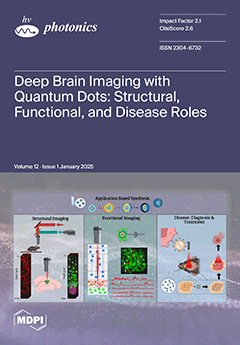To suppress the influence of aerosols scattering on the double-edge detection technique and achieve high-accuracy measurement of the wind field throughout the troposphere to the lower stratosphere, an ultraviolet 355 nm Rayleigh–Brillouin Doppler lidar technology based on a dual-pass dual Fabry–Perot interferometer (FPI)
[...] Read more.
To suppress the influence of aerosols scattering on the double-edge detection technique and achieve high-accuracy measurement of the wind field throughout the troposphere to the lower stratosphere, an ultraviolet 355 nm Rayleigh–Brillouin Doppler lidar technology based on a dual-pass dual Fabry–Perot interferometer (FPI) is proposed. The wind speed detection principle of this technology is analyzed, and the formulas for radial wind speed measurement error caused by random noise and wind speed measurement bias caused by Mie scattering signal contamination are derived. Based on the detection principle, the structure of the lidar system is designed. Combining the wind speed measurement error and measurement bias on both sides, the parameters of the dual-pass dual-FPI are optimized. The free spectral range (FSR) of the dual-pass dual-FPI is selected as 12 GHz, the bandwidth as 1.8 GHz, and the peak-to-peak spacing as 6 GHz. Further, the detection performance of this new type of Rayleigh–Brillouin Doppler lidar with the designed system parameters is simulated and analyzed. The simulation results show that at an altitude of 0–20 km, within the radial wind speed dynamic range of ±50 m/s, the radial wind speed measurement bias caused by aerosol scattering signal is less than 0.17 m/s in the cloudless region; within the radial wind speed dynamic range of ±30 m/s, the bias is less than 0.44 m/s and 0.91 m/s in the simulated cumulus cloud at 4 km where aerosol backscatter ratio
Rβ = 3.8 and cirrus cloud at 9 km where
Rβ = 2.9, respectively; using a laser with a pulse energy of 350 mJ and a repetition frequency of 50 Hz, a 450 mm aperture telescope, setting the detection zenith angle of 30°, vertical resolution of 26 m@0–10 km, 78 m@10–20 km, and 260 m@20–30 km, and a time resolution of 1 min, with the daytime sky background brightness taking 0.3 WSr
−1m
−2nm
−1@355 nm, the radial wind speed measurement errors of the system during the day and night are below 2.9 m/s and 1.6 m/s, respectively, up to 30 km altitude, below 0.28 m/s at 10 km altitude, and below 0.91 m/s at 20 km altitude all day.
Full article





